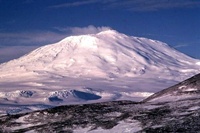Researchers discover active volcano under Antarctic ice
19 Nov 2013
An active volcano in the icy wastes of Antarctica, discovered for the first time, comes as fresh evidence that the frozen land is geologically active contrary to what might appear to be the case. Scientists fear the heat from the volcano could accelerate the loss of Antarctica's fragile ice sheet.
 The frozen continent has no dearth of volcanoes, though of the inactive type, with the most famous of these being Mount Erebus. However, while it was clear that there were also subglacial volcanoes, none of them were known to be active, according to Amanda Lough of Washington University, St Louis, Missouri.
The frozen continent has no dearth of volcanoes, though of the inactive type, with the most famous of these being Mount Erebus. However, while it was clear that there were also subglacial volcanoes, none of them were known to be active, according to Amanda Lough of Washington University, St Louis, Missouri.
The `New Scientist' quoted her as saying that this was for the first time that evidence of activity has been sited.
The activity was picked up by a network of seismometers that had been installed in Marie Byrd Land in western Antarctica over the last six years. Since their installation, the seismometers have detected two sets of tremors: one in January and February 2010, and the other in March 2011.
The tremors originated from depths of 25 to 40 kilometres, which meant they could not have been the result of the ice moving. Also given the fairly low frequency, between 2 and 4 Hertz, an earthquake could be ruled out. However, shifting magma is known to produce low, rumbling tremors.
From 2002 to 2011, the average annual rate of Antarctic ice sheet loss rose from around 30 billion tonnes to about 147 billion tonnes, according to the report of the UN's panel of climate scientists.
The ice sheet, a mass of glacial land ice covers parts of the earth, with one such sheet covering most of Greenland and the other Antarctica. Between them they contain most of the freshwater on earth.
The sheets are on the move continuously, as they flow downhill and seawards under their own weight. Portions extending out over the water are called ice shelf.
Earlier research had pointed to warmer
seas swirling in a circular fashion around Antarctica for the faster pace of ice sheet loss from the southernmost continent. According to the theory, the waters eroded ice shelves.
Also, as more of the shelves disappeared, the quicker the sheet would flow and lose ice to the sea.
However, according to Lough, the faster flow may also be due to volcanoes.
She says the volcanoes heated the underside of the ice, causing melting that lubricated the flow.
Using ice-penetrating radar, Lough and her team detected an intriguing elliptically-shaped deposit, measuring about 1,000 square kilometres (386 square miles) in western Antarctica, at a depth of 1,400 metres (4,550 feet). The deposit is said to be volcanic ash from an enormous eruption some 8,000 years ago.













.jpg)






.jpg)









